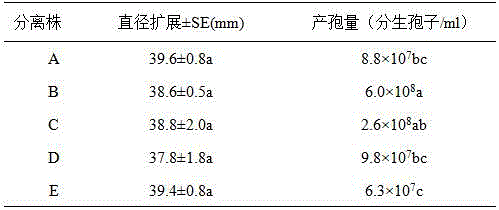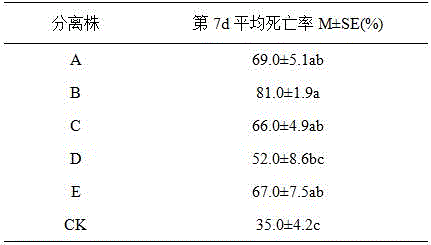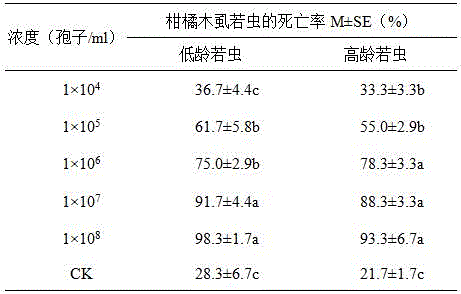Diaphorina citri Kuwayama high pathogenic Isaria fumosorosea strain and application thereof
A technology of Cordyceps rosacea and citrus psyllid, applied in the field of biological control, can solve problems such as excessive pesticide residues in fruits, loss of biodiversity, pollution of orchard ecological environment, etc., and achieve strong infection and insecticidal effect and strong application. potential effect
- Summary
- Abstract
- Description
- Claims
- Application Information
AI Technical Summary
Problems solved by technology
Method used
Image
Examples
Embodiment 1
[0019] Example 1 Isolation and identification of Ifusia fumoscens strain IF-BDC01
[0020] 1. Source of materials
[0021] (1) Sample: I. fumoscens was preserved by the Biological Control Engineering Research Center of the Ministry of Education of South China Agricultural University. The preserved sample of this strain was purified by single cell isolation.
[0022] (2) Potato dextrose agar medium (PDA): 200g peeled potatoes, cut into small pieces, add 1L of water, boil for 20min, filter with gauze: add 20g of glucose while hot, 18-20g of agar, stir to dissolve and mix, set Fill it into a Erlenmeyer flask and sterilize it in an autoclave (121°C, 30min) for 30min.
[0023] (3) Sterile operating conditions: All utensils and utensils must be sterilized in a pressure cooker (121°C, 30min), and inoculation and other operations are carried out in an ultra-clean workbench.
[0024] (4) Culture conditions: culture in a 25°C light (12L:12D) incubator. After the colony is formed, tran...
Embodiment 2
[0051] Example 2 Determination of the pathogenicity of the strain IF-BDC01 against young nymphs and advanced nymphs of the citrus psyllid
[0052] 1. Bioassay is one of the effective means to detect the lethality and lethality rate of entomogenic fungi to target pests, and can provide an important reference for comprehensive evaluation of the biological control potential of entomogenic fungi. In this study, IF-BDC01 strain IF-BDC01 was tested for its pathogenicity to young and old nymphs of citrus psyllids, in order to screen out the optimal age and concentration for its lethality to the two stages of citrus psyllids.
[0053] 2. Insects and host plants for testing: citrus psyllids. Adults of citrus psyllids were raised in the net room of the Biological Control Engineering Research Center of the Ministry of Education, and inoculated on clean and healthy Jiulixiang. Each plant of Jiulixiang was inserted with about 20 pairs of adults. A net made of PVC film was used to cover eac...
Embodiment 3
[0076] Example 3 Field control of I. fumigatus IF-BDC01 strain on citrus psyllid adults
[0077] 1. Treat adults of citrus psyllids with the spore suspension of I. fumoscens under semi-enclosed conditions. The cumulative mortality on the 7th day is shown in Table 8. With the increase in the concentration of I. fusca spores, lethal The rate is getting bigger and bigger.
[0078] Table 8 Mortality of I. fumosmos to adult citrus psyllids under semi-field conditions
[0079]
[0080] Note: The same letter in the same column in the table means that the difference is not significant at the 0.05 level (DMT method)
[0081] 2. The daily mortality rate of I. fumoscens to citrus psyllids in the field
[0082] The insecticidal effect of entomopathogenic fungi was relatively slow. After spraying, the citrus psyllids began to die on the 3rd day. After that, the mortality of citrus psyllid adults in the treatments of various concentrations continued to increase, and increased with the ...
PUM
| Property | Measurement | Unit |
|---|---|---|
| diameter | aaaaa | aaaaa |
Abstract
Description
Claims
Application Information
 Login to View More
Login to View More - R&D
- Intellectual Property
- Life Sciences
- Materials
- Tech Scout
- Unparalleled Data Quality
- Higher Quality Content
- 60% Fewer Hallucinations
Browse by: Latest US Patents, China's latest patents, Technical Efficacy Thesaurus, Application Domain, Technology Topic, Popular Technical Reports.
© 2025 PatSnap. All rights reserved.Legal|Privacy policy|Modern Slavery Act Transparency Statement|Sitemap|About US| Contact US: help@patsnap.com



